Of all the plants known to assist in air purification, peace lilies rank near the top of the list. These aesthetically pleasing indoor foliage plants boast the ability to neutralize both toxic gasses and formaldehyde.
The above-mentioned advantages have helped brand peace lilies as an extremely popular houseplant.
Some of the most common problems when growing these plants are wilting foliage, browning leaves or leaf tips, yellow leaves, or, in some cases, the peace lily flower turning black.
These issues mostly arise from overwatering and pest infestation. However, poor soil composition is generally the root cause. The other 2 problems are more of a domino effect.
In this article, we’ll look at various causes of peace lilies turning brown or black. We’ll also provide some solutions for if or when these issues occur. Let’s dive in, shall we?
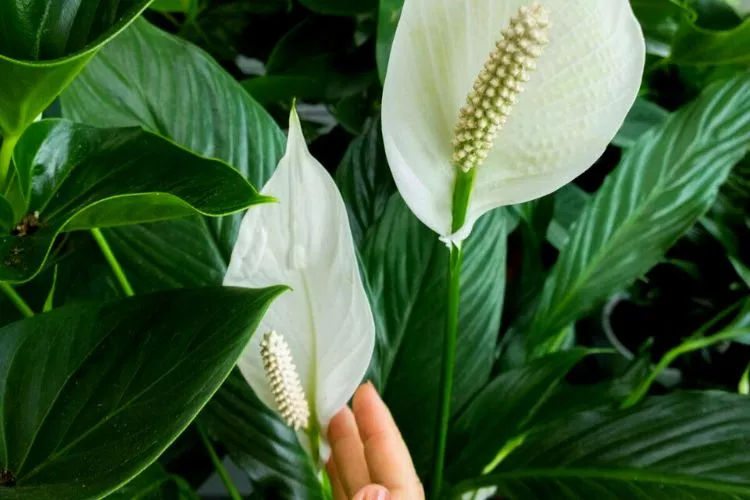
Table of Contents
Causes of Peace lily flower turning black/brown
When plants become stressed, they usually present some sort of visual sign. As growers, we try to read these signs while using some detective work to distinguish the cause. It generally takes a process of elimination to help heal or rebalance the condition.
Peace lilies are no different in the way that they grow and provide us with these clues in their weakened state. Let’s look at all the reasons why a peace lily can turn brown or black.
Improper Watering Schedule
Peace lilies are a little picky with their water. Firstly, tap water, instead of rain or distilled water, can clog the soil up with excess salt and mineral deposits. When the soil is in this condition, it struggles to absorb water which ends up pooling around the roots.
When the roots are bathing in the excess water, they rot out and slowly kill the plant from the bottom up. As the rot spreads through the plant, it slowly discolors it from yellows to browns to black. The roots will become mushy, and the plant, unfortunately, becomes barely savable.
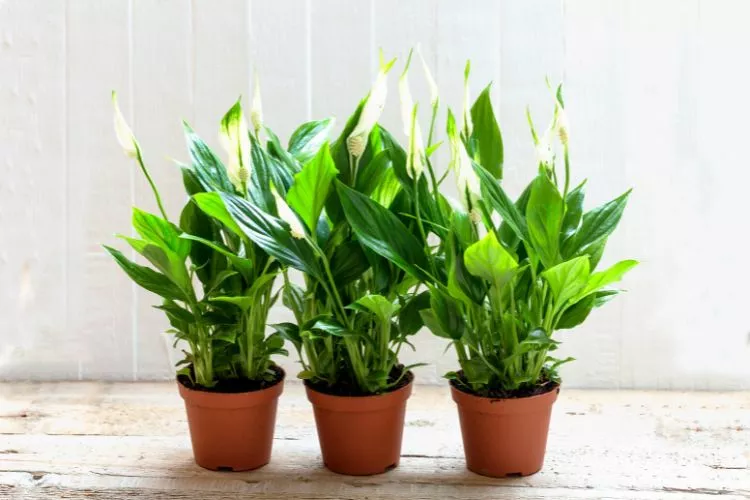
It’s not just the type of water that is problematic either. Poor soil condition also plays a huge role in water management which we’ll get to soon. As you can imagine, overwatering would be the ultimate threat when some of the previously mentioned roadblocks are present.
Quite often, it’s hard to know what’s happening under the soil without pulling the plant up to check out the condition of the root system.
So, excess amounts of moisture will also turn a peaceful lily black via pooling and rotting. Preparing a plant like this with adequate drainage is essential!
Stress
General stress can arise from various resolvable issues such as excess heat, poor access to light, inadequate spacing, which causes humidity issues, etc. The list goes on.
All of these problems, solo or combined, can turn a peaceful lily into all sorts of colors, including black. In most cases, the remedy involves simply relocating the plant and giving it/them some time to adjust to its new surroundings.
Pesticide or chemical damage
Overuse of pesticides, fungicides, fertilizers, and other chemical solutions can burn the foliage of the peace lily plant. As a result, they will slowly turn brown and black if left unattended.
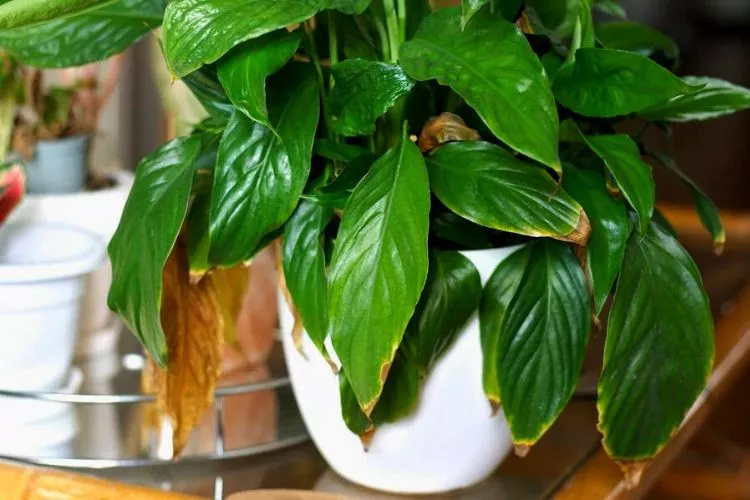
These issues generally begin on the leaf tips and then work their way in if the problem persists. Always follow the recommended guidelines and even weaken the dosage to avoid being confronted with these burning problems.
Poor drainage
Poor drainage is usually the root cause (mind the pun) of most long term planting issues. The peace lily is a little tricky to balance regarding soil composition choice.
On the one hand, they need moisture retention but also require drainage, which sounds almost counterproductive.
They want the moisture readily available but don’t want so much that their delicate root system drowns in it. Put simply, they want moist soil that isn’t soggy. You can purchase specialty mixes designed to suit the needs of peace lilies.
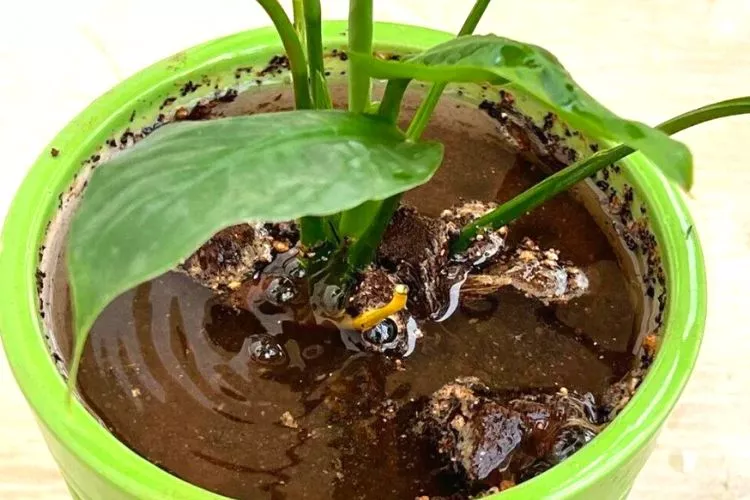
However, you can also create your own by mixing 2 parts of a regular indoor potting mix or cactus mix with 1 part of bark or perlite.
The first 2 parts help with retention, and the last assists in drainage and increase aeration. Poor drainage traps water that pools and can rot out the roots. As a result, the plant will usually turn black.
Natural Aging Issue
As peace lilies grow older, they shed their leaves to preserve their energy and slow down their aging process. As a result, the leaves will wilt and turn black before dropping off.
Lack of Proper Care
Proper care is tied into most of the previously mentioned problems. We’ll get to some preventative measures and solutions shortly, but practicing frequent maintenance measures will ensure that your plant stays healthy and happy for as long as its life span allows.
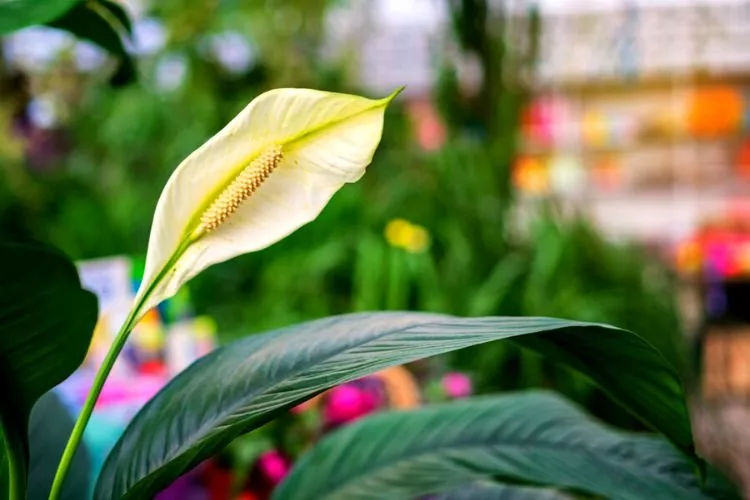
If simple things such as moving them around to receive enough sunlight or taking it easy with the amount of water they receive aren’t adhered to, they will become stressed and turn a range of colors. It’s not uncommon for spots to appear, burning of leaves, yellowing, browning, or blackening of foliage, etc.
Fungal or bacterial infections
Fungal or bacterial infections can be caused by a few different malpractices or other forms of neglect. For example, poor spacing can raise the humidity and form mold in the crevices, bringing on powdery mildew and black spots. Peace lilies like high humidities.
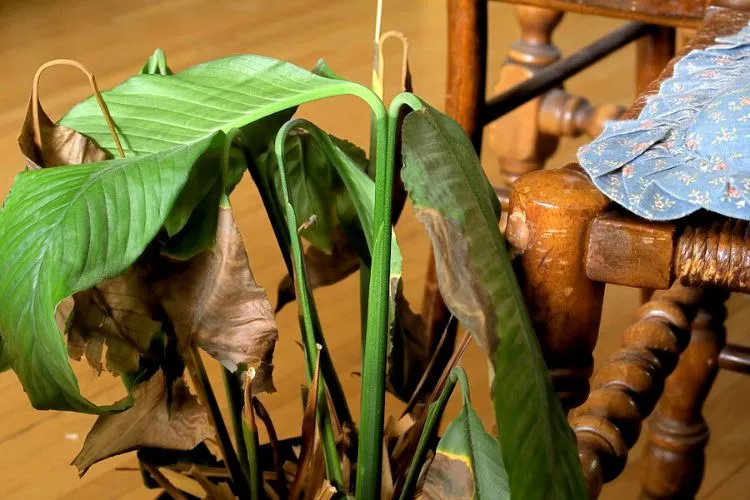
They thrive in up to 75%, but any higher can see them struggle. Other fungal or bacterial infections can come from pathogens leaching upon purchase or root rot. Blackening can come in many forms, such as black spots, black leaf tips, black roots, stems, etc.
Insect infestations
The most common cause of insect infestations is when overwatering occurs, and the plant is weakened from the resulting rot. Insects such as aphids, mealybugs, spider mites, and thrips will latch onto the plant and suck the life out of it. As a result, they leave black spotted marks, which can weaken the plant even further.
Nutrient deficiencies
When peace lilies aren’t receiving enough nutrients, they can form necrosis spots, which are black spots with red rings around the edges. Depending on the severity, they can also become dark around the tips, middle, and/or edges.
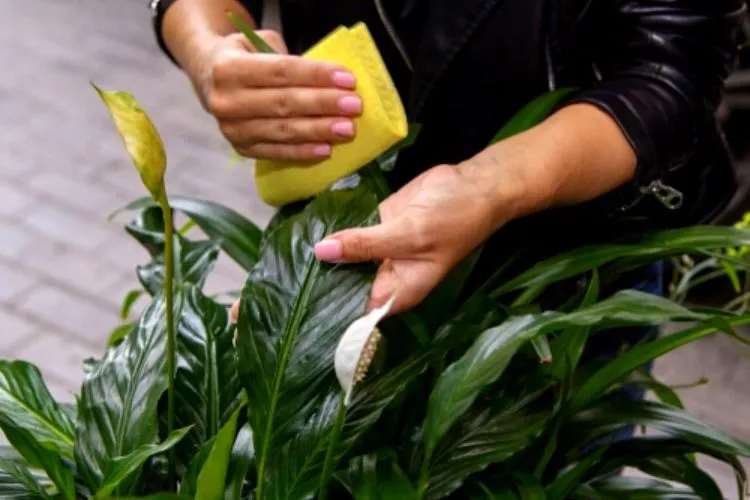
Nutrient deficiencies are often caused by hydration. They need water to dissolve, so without it, the plants cannot receive the food they need to grow strong and healthy.
Cold temperatures
Peace Lilies are native to tropical rainforests, so they prefer warm and humid conditions. Therefore, growing them in colder conditions will stress them, and they will slowly turn black as a result. Their leaves will wilt and rot and slowly decay before dropping off.
Anything below 40°F (4.5°C) will shock their systems. You should aim to have them growing at around 65-85°F (18-30°C) for optimal results.
How to Prevent Peace lily flower from turning black/brown?
After combing through all of this important information, it’s understandable that you may feel overwhelmed by the many things that can turn a peaceful lily black.
However, you can take a few preventative measures to ensure that the issues don’t arise in the first place.
Here are some simple adjustments you can make and keep in mind before and during the early stages of your peace lilies’ growth.
Use proper watering techniques
Peace lilies like their soil to be moist but not soaking. When their roots sit in stagnant water at the base of their growing container, they can easily succumb to root rot. Aim to keep the top 1 inch of the soil moist and allow it to dry completely before applying any more water.
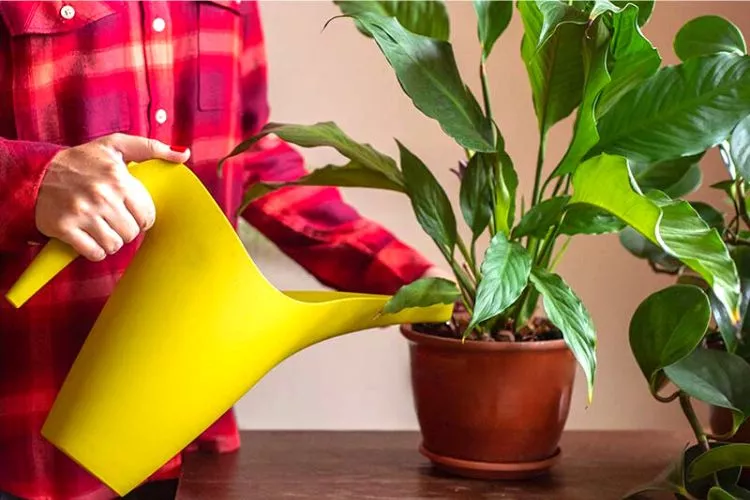
It’s best to pour the water in from the top (at the base of the plant) without a saucer and allow the water to drain out before standing the container back on the saucer. This way, you know that there isn’t any water pooling in the saucer that the roots can rot in.
A simple way to test the soil moisture content is by sticking your finger down 3-4 inches beside the stem and seeing how wet or dry it is as it comes out.
Maintain a Healthy Temperature
Peace lilies thrive best when the daytime temperatures are between 68-85 °F (20-29°C) and during the nighttime when the temperature drops to around 10°F cooler.
It’s best to relocate your peace lilies when it drops below 60°F (15.5°C) during the day or night as these plants are sensitive to cold climates.
Don’t Over Fertilize
Peace lilies don’t require much in the way of fertilization and can become damaged with too much. If needed, you can encourage growth by using a houseplant fertilizer starting from the very end of winter.
This will help recharge the plant and prepare it for the spring and summer seasons, where they do most of its growing. This can be done every 6 weeks or so from the first feed and step down their feeding around mid late spring/early summer.
Avoid Tap Water
When it comes to water choice, peace lilies are better treated with filtered water. Tap water generally contains enough fluoride, chlorine, and other contaminants such as aluminum, arsenic, copper, and iron to harm the sensitive nature of these types of plants.
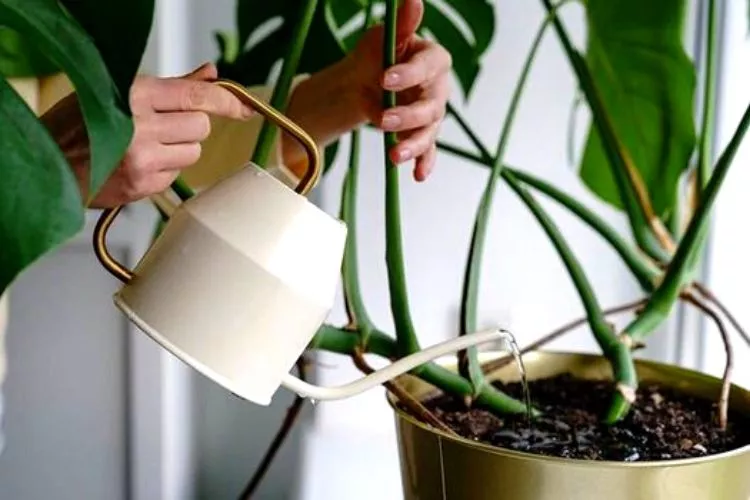
When these contaminants build up in the soil, they can easily dehydrate the plant, which doesn’t allow any nutrients to dissolve. As a result, the plant receives no form of nourishment which stunts its growth and finally kills them.
Avoid chemical pesticides
Chemical pesticides tend to burn the sensitive foliage of a peaceful lily. Therefore they should be avoided at all costs. There is a range of organic pesticides that you can use that have an equal or even better effect when applied correctly.
Peace lilies are generally pretty resistant to pests. Using a product such as neem oil will keep the condition of the plants in a healthy state, which in turn helps to keep any invading pests away. They usually only latch onto weak and suffering plants as they find it easier to attach and feed in this state.
Treating fungal or bacterial infections with appropriate remedies
When fungal or bacterial infections aren’t treated promptly, they can become absolute nightmares to deal with. So bad that they can often become untreatable. The hardest hitting infection is root rot. Surprisingly, treating this condition isn’t a simple fix.
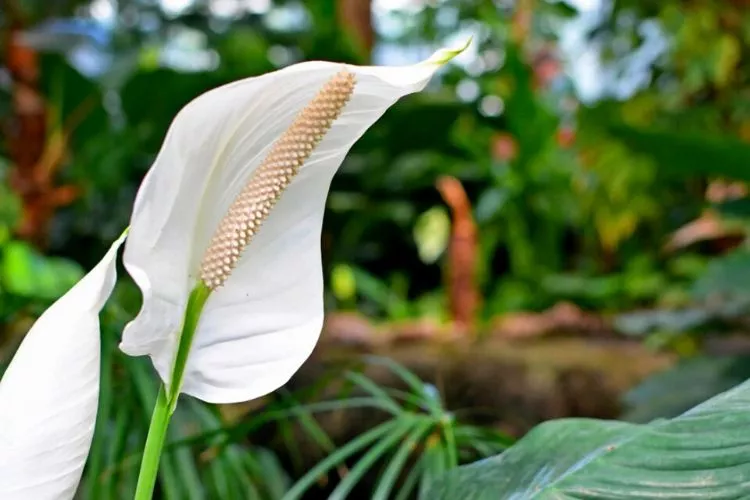
Firstly, the roots need to be exposed and inspected. Then you may need to prune away decaying or mushy roots. If there are still some signs of life at the base of our peace lily, you can usually report with a better quality soil blend. You can also do a soil drench using an organic fungicide mix.
These can be blended using 1 quart of water with 1/4 teaspoon of baking soda and vegetable or horticultural oil and sprayed on the affected areas.
How Long Do Peace Lily Flowers Last?
Peace lilies won’t produce flowers until they reach maturity, usually around one year. Some peace lilies take up to 3 to 5 years to reach this stage, so it’s a matter of being patient with these beauties, unfortunately.
The actual flowering or blooming period of a peace lily usually lasts between 1 to 2 months, depending on how well the growing conditions were optimized.
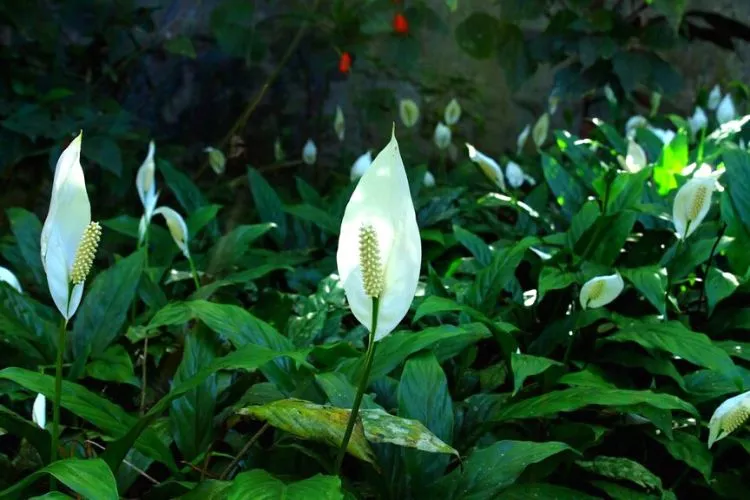
If they are extremely well treated, there are cases of them lasting even longer. Furthermore, they can flower up to 2 times per year. The first occurs in the spring, and the second usually happens during fall. Once the flowers show off, the leaves will turn brown, green, or become droopy.
The plant itself isn’t dying, just the flower, and it will bloom the following year and up to 3-5 more years after that again. The amount of times they can flower per year also depends on their growing conditions.
Frequently Asked Questions (FAQs)
Can You Prolong The Life Of Your Peace Lily Flowers?
Using room temperature filtered water can assist by not having countless contaminants such as fluoride, chlorine, zinc, nickel, etc. These additives can clog the soil and dehydrate the plant by not allowing water to penetrate the root system.
Just watering, in general, can help it to stay hydrated. As long as they are watered gently and not soaked, they will stay happy and healthy, lasting much longer.
Should I cut black leaves off peace lily?
Black leaves can be simply pruned at the base. Once removed, the plant can focus a lot more of its energy on regenerating the healthier parts. By doing this, you will notice an uptick in foliage and the overall health of the plant.
Should you remove old peace lily flowers?
Beheading is a practice that should be done with care, especially when treating the sensitive peace lily plant. Once the flowers have completely shriveled up, cut them cleanly and slightly angled at the base with a sterilized pair of pruning shears. Doing so will help them to regenerate more effectively.
Conclusion:
When the wonderful, peace lily flowers start turning black, it’s a sure sign that they are under some kind of stress. Nearly all plants suffering will offer a visual sign to help determine what their issue may be to resolve it.
Blackening of the peace lilies leaves usually means that they are either being overwatered, having a poor soil composition, aging, or even being affected by pests or diseases.
Whatever the reason, correcting it before it’s too late is vital. The beauty of such problems is that all it takes is a few minor tweaks. This could mean relocating the plant, repotting with soil more suited to the plant, or even reducing the water intake.
All in all, gardening should be a learning experience. We hope that this guide has been helpful. You can read about similar topics here on our website. Check back again soon for more.


